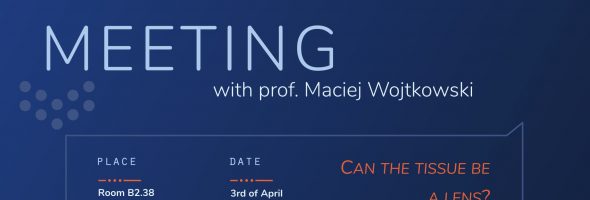Chcemy serdecznie zaprosić na spotkanie z prof. Maciejem Wojtkowskim, który przygotował dla nas prezentację „Can the tissue be a lens?” („Czy tkanka może być soczewką?”). Maciej Wojtkowski zaprezentuje jeden ze swoich obecnych projektów badawczych, który koordynuje jako Lider Zespołu w grupie badawczej Optyki Fizycznej i Biofotoniki w Instytucie Chemii Fizycznej PAN.
Maciej Wojtkowski to jeden z czołowych polskich ekspertów w obszarze biofotoniki. Niedawno otrzymał prestiżowy grant „Międzynarodowa Agenda Badawcza” Fundacji Nauki Polskiej na stworzenie nowego instytutu badawczego. W 2012 roku również FNP przyznała mu Nagrodę Fundacji, nazywaną często „Polskim Noblem”.
Wierzymy, że spotkanie z Maciejem Wojtskowskim będzie unikalną okazją poznania jego projektów badawczych i zadania pytań o jego ścieżkę kariery.
Spotkanie jest zaplanowane na 3 kwietnia 2019, o godz. 17:30 w sali B2.38 Wydziału Fizyki UW. Abstrakt wykładu w wersji angielskiej dostępny poniżej. Po części oficjalnej spotkania zapraszamy wszystkich do przyłączenia się do kontynuacji dyskusji w mniej formalnej atmosferze w pobliskim pubie.
[English version]
We would like to invite for meeting with prof. Maciej Wojtkowski who prepared for us presentation “Can the tissue be a lens?”. Maciej Wojtkowski will present one of his ongoing research projects which he coordinate as Team Leader in Physical Optics and Biophotonics research group in Institute of Physical Chemistry PAS.
Maciej Wojtkowski is one of the leading experts in Poland in field of biophotonics. Recently he received prestigious grant “International Research Agenda” from Foundation for Polish Science to establish new research institute. In 2012 the same Foundation granted him FNP Prize which is often called “Polish Nobel Prize”.
We believe that meeting with Maciej Wojtkowski will be an unique opportunity to discover his research projects and ask him question regarding his career path.
The meeting is scheduled for 3rd of April 2019, at 17:30 in room B2.38 in Faculty of Physics of University of Warsaw. After the official part of the meeting we would like you to join in one of the nearby pub to continue discussion in less formal atmosphere.
Abstract:
One of the most appealing and still unsolved problems in biological and medical imaging is the possibility of non-invasive visualization of tissue in vivo with an accuracy of microscopic examination. It is especially emphasized nowadays in era of novel microscopic techniques, which have ability for optical depth sectioning without need of processing samples.
The main physical limitation of the in vivo microscopic imaging is associated with light scattering introduced by irregular and often discontinuous distribution of refractive index. Scattering of light limits the number of ballistic photons delivered to and received from the sample. As a consequence, the contrast of reconstructed images is compromised dramatically by increased noise. Another side effects of uneven distribution of the refractive index are significant deformations of images. Additionally, in case of coherent illumination with laser light there is a disturbing presence of so-called speckles – strong fluctuations of intensity caused by interference of mixed transverse modes of the laser beam. Speckle noise also degrades system resolution and reduces image quality. Adding all of these effects results in severe loss of imaging information.
In our work we try to solve these fundamental physical limitations by developing new optical coherence imaging techniques, which utilize spatio-temporally partially coherent light with access to intensity and phase of detected radiation. In our research activity we focus on developing new optical methods that enable to image biological objects in vivo and in minimally invasive way. We went long way covering significant spectrum of various sizes of objects – from organ-size scale up to internal structure of a single cell.


